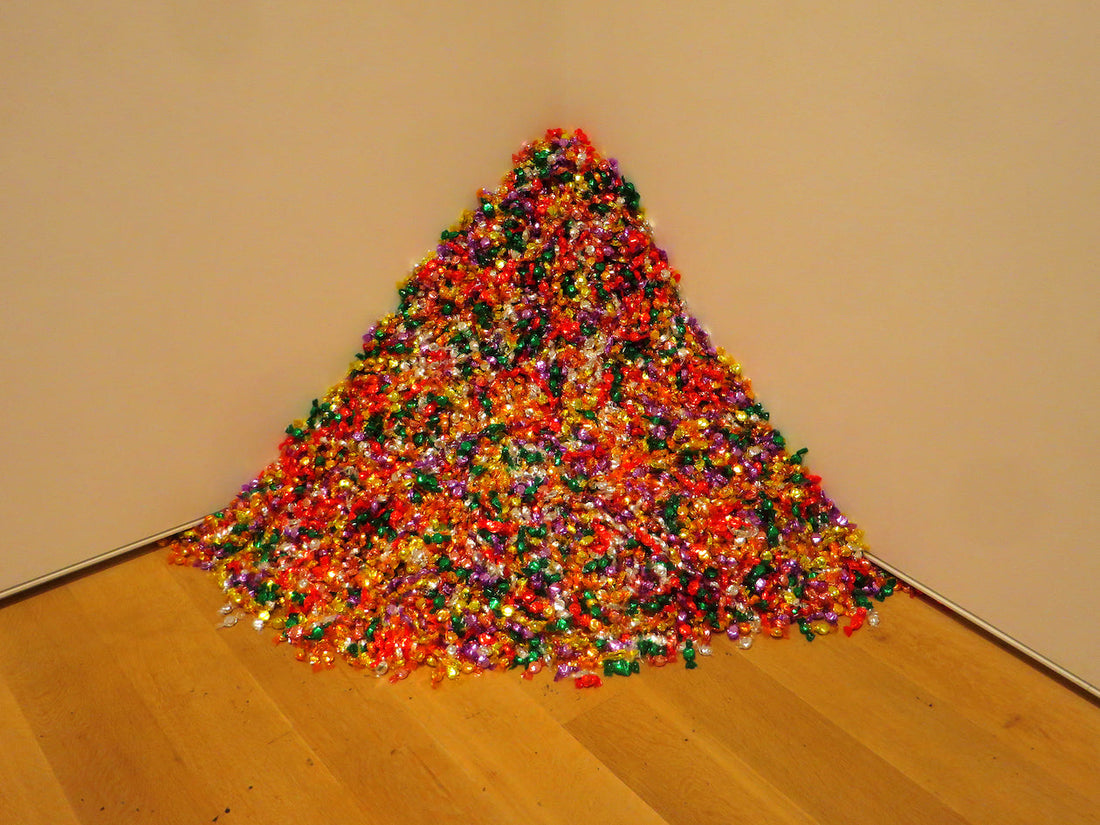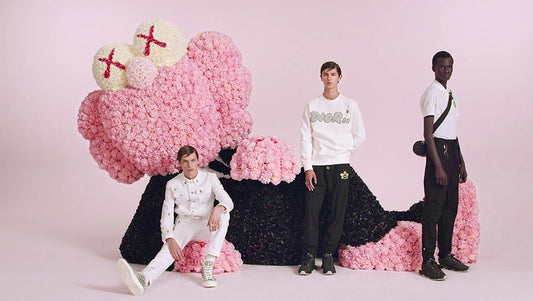If you are interested in unique, meaningful art pieces that lean heavily into concept, you might already know the story—deep in a corner within the Contemporary Art wing of the Art Institute of Chicago, in Gallery 293, lies a large pile of candy. A 175-pound pile of candy, to be exact. The candy pile is the art, and yes, you can touch it.
The installation is Felix Gonzalez-Torres’ 1991 work “Untitled” (Portrait of Ross in LA), and it’s much more than just a simple, “lazy” piece of object art for visitors to snag free sweets from. With a heart-wrenching backstory, a thought-provoking premise, and an integral component of LGBTQ+ art history, “Untitled” (Portrait of Ross in LA) has left a legacy spanning over 30 years. Thanks to social media, it’s being introduced to a younger generation. Let’s take a deep-dive into what makes this experimental sculpture one people keep talking about.
Who Was Felix Gonzalez-Torres?
To understand why “Untitled” (Portrait of Ross LA) still resonates today, it’s essential to take a look into the life and personal experiences of the artist himself.
Born in Cuba in 1957, Gonzalez-Torres obtained a BFA in photography from Pratt Institute in New York in 1983. He then received an MFA from the International Center of Photography and New York University in 1987. In addition to his photography, which was displayed on billboards in various locations, González-Torres chose to use everyday, common objects in his physical art installations such as paper, clocks, string lights, and of course, candy.
Gonzalez-Torres was an openly gay man and many of his works grappled with themes such as “love and loss, sickness and rejuvenation, [and] gender and sexuality,” according to the Guggenheim Foundation. His work was intrinsically linked to his queer identity, his relationships, and the sociopolitical nuances of the AIDS crisis of the 1980s and 90s, during which the majority of his work was created.
Felix Gonzalez-Torres died in Miami in 1996 of AIDS-related complications.

What Is the Meaning Behind “Untitled” (Portrait of Ross in LA)?
Viewers don’t necessarily have to understand the meaning behind “Untitled” (Portrait of Ross in LA) to engage with it as an interactive piece. Nenette Luarca-Shoaf, director of adult learning at the Art Institute of Chicago explains that“there’s always this kind of joy, common joy, that people have in being able to eat a piece of candy”.
That joy becomes replaced with a somber revelation, though, once the viewer realizes that the 175-pound pile of candy is supposed to represent Gonzales-Torres’ romantic partner, Ross Laycock, at a healthy weight before AIDS-induced weight loss. The use of the word “portrait” in the work’s title supports this, and as viewers take candy from the pile until there is nothing left, they simulate the slow, gradual decay of Laycock’s body due to the virus.
Although Laycock passed from AIDS-related complications in 1991, the same year the work first debuted, he lives on through the work as the candy pile representing his body can be endlessly replenished.
Laycock’s death was the driving inspiration behind many of Gonzalez-Torres’ object art pieces. Laycock’s battle with AIDS is the prominent focus of his series of “candy works, ”of which “Untitled” (Portrait of Ross in LA) is one of 20. All of the candy works came with specific installation parameters outlined by Gonzales-Torres.
Some of the candy works suggested ideal weights correspond to that of one or two healthy adult men (representing Laycock or both Gonzales-Torres and Laycock). The type of candy used and its physical arrangement in the exhibition location is up to the exhibitor’s discretion.
Gonzales-Torres always invited viewers to create their own interpretations and meanings for his works. On a personal level, he created “Untitled” (Portrait of Ross in LA) to represent the love he and Laycock shared during their short time together.
When asked in a January 1995 interview with Robert Storr for ArtPress (archived by Queer Cultural Center) who his art was for, Gonzales-Torres stated that “When people ask me, ‘Who is your public?’ I say honestly, without skipping a beat, ‘Ross.’ The public was Ross. The rest of the people just come to the work”.
This undeniable expression of the joy, sweetness, and purity of love juxtaposed with the pain of anticipatory grief is one of the reasons why this work continues to resonate with viewers today.

Why Does This Piece Keep Going Viral?
If you were to take a look at any TikTok or Twitter thread asking for responses on artworks, users find the most moving or emotionally impactful, “Untitled” (Portrait of Ross in LA) is constantly brought up.
Many provide the heartbreaking context of Gonzales-Torres and Laycock’s relationship, while others share their own interpretations of the piece and its meditation on broader themes such as love, loss, and death—all relatable and universal feelings for people of any identity around the globe.
But what makes this piece so unique is its position within AIDS-era art and LGBTQ+ art history. The early decades of the AIDS crisis in the U.S. primarily affected gay men and other marginalized groups, who were already facing discrimination from the general public and the government. This led to further stigmatization of the LGBTQ+ community, and for queer artists, an AIDS diagnosis was like a ticking time bomb.
For some, there was no other way to cope with this devasting blow to the community than through art activism, such as the 1987 poster “SILENCE=DEATH” created by Avram Finkelstein, Brian Howard, Oliver Johnston, Charles Kreloff, Chris Lione, and Jorge Socarrás of the SILENCE=DEATH Project.
When discussed on social media, “Untitled” (Portrait of Ross in LA) is often brought up in conjunction with works like Gonzales-Torres’ own “Untitled” (Perfect Lovers) and Keith Haring’s “Unfinished Painting”. Both of these works address the lack of time both artists had to live their lives due to AIDS, which has no cure.
Today, the AIDS crisis remains a critical and influential part of LGBTQ+ history. It has shaped the community’s larger identity into what it is now. “Untitled” (Portrait of Ross in LA) encourages viewers to celebrate the communal joy of a marginalized community that has survived and endured many hardships while reflecting on those lost much too soon.

The LGBTQ+ community no longer faces the threat of AIDS at a disproportionate rate like it once did. However, there are still new challenges to overcome with the recent increase of legislation that targets the rights of transgender individuals and LGBTQ+ history education.
Felix Gonzales-Torres’ work is a testament to the unbreakable spirit of the queer community and the legacy of AIDS-era artists. It will undoubtedly continue to hold weight as an important piece of art for as long as the candy in it is replenished.
So if you ever come across this striking pile of colorful candies in Chicago, think about taking a piece or two. You’re supposed to, after all.
©ArtRKL™️ LLC 2021-2023. All rights reserved. This material may not be published, broadcast, rewritten or redistributed. ArtRKL™️ and its underscore design indicate trademarks of ArtRKL™️ LLC and its subsidiaries.





